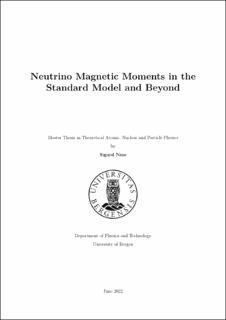Neutrino Magnetic Moments in the Standard Model and Beyond
Master thesis
Permanent lenke
https://hdl.handle.net/11250/3000410Utgivelsesdato
2022-06-01Metadata
Vis full innførselSamlinger
- Master theses [170]
Sammendrag
This thesis presents the theory describing the magnetic moments of Dirac and Majorana neutrinos, including a systematic method for extracting the neutrino magnetic moments from a given theory using electromagnetic form factors. In the standard electroweak interactions, neutrino magnetic moments are suppressed by the small neutrino masses. Theories beyond the Standard Model which overcome this suppression lead to unacceptably large loop corrections to the neutrino masses, necessitating fine-tuning of model parameters. This model building issue, and a mechanism for avoiding it using a global symmetry, are discussed. The excess in electron recoil events reported by the XENON1T collaboration may be interpreted as a neutrino magnetic moment many orders of magnitude above the Standard Model prediction. Adopting the interpretation of this excess as a transition magnetic moment from an active neutrino to a sub-MeV sterile neutrino, leptoquark models with couplings to right-chiral neutrinos are explored. A recently proposed scalar leptoquark model, which generates large magnetic moments without fine-tuning, is investigated. A vector leptoquark model is proposed to simultaneously explain a large neutrino magnetic moment and recent data on lepton flavor universality violating observables. If fine-tuning of the neutrino mass is accepted, the model can accommodate the desired observables simultaneously.
